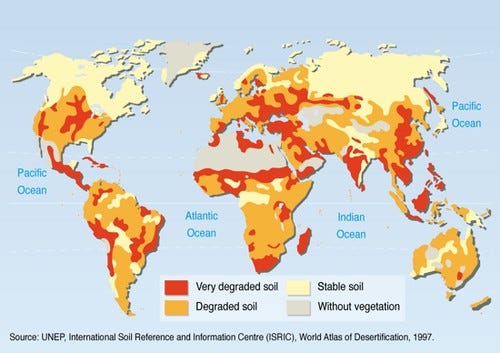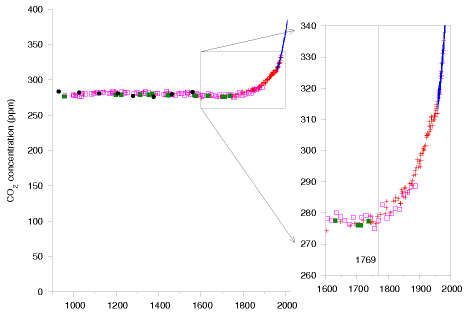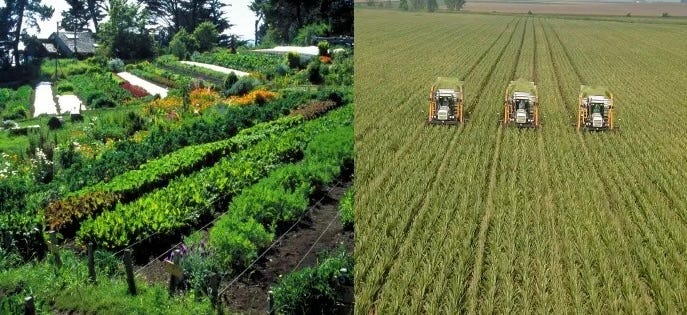Less than a century ago, after the industrialized world had experienced widespread modern warfare and the following growth of global populations gave cause to the anticipation of mass food shortages, a new, revolutionary type of agriculture was implemented to keep up with global economic trends. Otherwise known as the Third Agricultural Revolution (after the Neolithic and British), the Green Revolution implemented everything the industrial world had to offer; modern technologies, agrochemicals and synthetic fertilizers, mechanical inventions taking the place of human labor, mass assembly, distribution and marketing, among other adaptations.
While the intentions of agricultural development were mainly a response to surging populations in Third World countries and socio-political changes occurring in the post-industrial West, the effects were vastly intensified by organizations like the U.S. Agency for International Development (USAID) and the Nixon and Ford administrations. Earl Butz, who served as the Secretary of Agriculture during this time coined mottos for American farmers such as “get big or get out,” and “fencerow to fencerow” (implying that commodity crops ought to be farmed from every available square foot of land). His economic policies are in many ways responsible for the decline in financial stability for local family farms, and the significant increase of major agribusiness corporations.
Photo: author with writer/researcher David Montgomery at the Nobel Scientific Conference
The Green Revolution, and its subsequent widespread use of agrochemicals and other industrial farming methods, initially boosted crop yields and allowed more famished parts of the world access to food. Although the benefits from these technologies are tremendous, they are only temporary solutions which prove incapable of sustaining food availability long term. Currently, at least a third of the world’s agricultural land has been degraded, and continues to erode at a rate of almost half a percent each year for the global capacity of crop production, according to a report released by the United Nations Food and Agricultural Organization. Agrochemical runoff, atmospheric carbon release, desertification, and less nutritious food are other problems associated with certain modern farm industry practices.
To solve issues of ecological preservation and soil fertility, farmers, researchers and academic dissidents are exploring alternative, even traditional, means of food production. Engagement with small-scale, localized, ecologically-conscious and traditionally agrarian growing techniques may be an effective way to curb current trajectories. Alternative food systems such as these have also shown to boost crop yields for farmers and generally produce more (and better quality) food than current global commercial food systems, as well as to sustain the health and overall quality of the land.
Conservation agriculture can be understood as an all-encompassing concept that facilitates sustainable, healthy trends in farming, with the central focus of maximizing soil fertility. Three core ideas are involved with conservation agriculture: minimal tilling and disturbance of the land; permanent ground cover using a “cover crop”; implementing crop rotation using a diversity of plants, not single-crop fields (monoculture).
The main component driving soil fertility is the abundance of microbial life within the soil, which breaks down organic matter so it can be taken up by plants as nutrients and minerals. Use of agrochemicals like nitrogen fertilizer and pest/herbicides weaken the plants, and inhibit their ability to attract microbes, and therefore nutrients and minerals, to their roots. According to a study conducted by Johnathan G. Lundgren, fields treated with insecticide experienced ~ 10 times the abundance of pests than regenerative farms free of agrochemicals. Combined with large-scale land tillage (which leaves soil susceptible to erosion and carbon loss), agrochemicals can potentially desertify fertile soil, transforming it into lifeless dirt. Chemical application also has the tendency to leach into water sources (most agrochemicals are designed to be soluble) either through the soil or by runoff.
Figure 1: soil degradation throughout the world
Tilling the earth tends to break up the networks of mycorrhizal fungi responsible for nutrient distribution, and since the photosynthesis of plants stores carbon (organic matter) underground, turning up the land releases carbon (most plows are 15 to 20 cm), allowing it to bond to other molecules in the air. In the last 200 years, ~ 80 billion tons of carbon has been lost from the earth’s soil (80% loss in historically cultivated land). Utilizing cover-crop farming and alternative methods to tilling can significantly reduce the release of carbon, and also sequester carbon from the air and put it back into the ground. Currently (2013) the atmospheric concentration of CO2 (carbon dioxide) is ~ 400 ppm (parts per million), which is 50 ppm beyond what some experts consider “stable” for Earth’s climate.
Figure 2: atmospheric CO2 levels have risen significantly since the Industrial Revolution
Permanent ground cover and minimal land disturbance keeps the soil intact and can prevent weeds from overtaking a field, as well as provide organic matter by leaving crop residue on topsoil. Topsoil erosion from conventional farms happens at an average rate of ~ 1.5 mm/year, but typical landscapes will only produce topsoil at ~ 0.02 mm/year by nature (it can take 1,000 years to make an inch of soil). Most of the fertile components lie in the topsoil, and loss of fertility will cause a field and crop to be dependent on synthetic agrochemicals, which in turn shuts down the natural processes of nutrient, mineral, and phytochemical extraction, as well as a plant’s resistance to pathogens.
Monoculture (single-crop) farming is also a contributor to loss of soil fertility, because growing only one type of crop year after year will diminish nutrients from the ground. For example, wheat is known to deplete nitrogen levels in soil, so planting wheat every season does not allow time for the field to “recover” a balance of nitrogen. Most varieties of legumes, however, are considered to be “nitrogen fixing” crops, meaning they attract microorganisms that convert atmospheric nitrogen (N2) into ammonium (NH4+). Plants can only use nitrogen if it is combined with hydrogen or oxygen (ammonium or nitrate/NO3-), as this makes the nitrogen water soluble and therefore allows it to be absorbed by roots. Farmers that utilize crop rotation will typically plant a series of complementary crops in the same field, changing what is grown there each season. Another technique is to alternate crops throughout the same field in one season (e.g. plant corn and beans every other row).
Figure 3: permaculture vs. monoculture farming in practice
One last innovative solution worth noting for the revitalization of sterile land is the use of compost, as well as animal and human waste to return nutrients back to the ground. In the past, certain cultures utilized excrement and plant remains to enrich their soil, and actually regarded such things as a precious resource. This practice has been known by many names with subtle variations: Terra Preta, European Plaggen (anthropogenic sod), Nordic Black Earth, Bavarian poudrette, and Chinese night soil. From classical Greece to the Amazon rainforest, methods of human-applied biosolids have shown to not only reverse erosion, but build up thick layers (sometimes 2 meters) of soil in a short amount of time, which is often found to be incredibly fertile thousands of years later.
A fair criticism of this method is the presence of artificial components in human waste, such as pharmaceutical drugs and unnatural food ingredients, but evidence of serious health risks from biosolids have not yet been documented by published studies. In fact, most research has shown low concentrations of pharmaceuticals and personal care products in biosolids, and author David Montgomery suggests that the artificial constituents found in sewage are broken down by anaerobic digestion and aerobic composting, along with other biological factors. Biosolids are composed of 60-80% water and 4-10% carbon, but are also rich in nitrogen, phosphorus, sulfur and trace minerals and micronutrients needed by plants, including boron, calcium, cobalt, copper, zinc, iron, magnesium, and manganese. The makeup of biosolids fits a universally recognized profile of healthy soil, and could potentially be a useful remedy for restoring degraded land across the world.
While commercial agricultural practices have generally proven to produce negative long-term outcomes, the technological and chemical innovations ought not be altogether shunned and done away with. After all, much of what is currently implemented by the modern food industry is not merely the result of short-sighted economic policy, but also of ingenious and inventive minds which sought to push scientific barriers. Perhaps, under the discipline of a collective restraint, harmful products like pesticides and herbicides can be used instead for constructive purposes such as controlling the proliferation of invasive species which crowd out native plants and animals, which disrupts the balance of a healthy ecosystem. Likewise the plough, a long-held symbol of the Western agrarian, can be used to break up already compromised fields of infertile soil and restore their proper levels of organic matter to that of self-regulation. As bleak as current situations might seem, in regards to food and natural resources, the solutions are in plain sight, and they are easy to attain in a way that is economically feasible. It is simply a matter of willpower, and for the right people to assume leadership by sheer force of personality, or otherwise.
Sources
[7] S. Pal, “50 Years of IR8: A Tribute to the 'Miracle Rice' that Helped India Fight One Of Its Worst Famines,” The Better India, 21-Dec-2016. [Online]. Available: https://www.thebetterindia.com/76041/ir8-miracle-rice-irri-india-famine-gurdev-khush/. [Accessed: 07-May-2019].
[8] Montgomery, David. Growing a Revolution: Bringing Our Soil Back to Life. W.W. Norton & Company. 2018
[9] Montgomery, David. Dirt: The Erosion of Civilizations. University of California Press. 2007.
[10] Rattan Lal address to Nobel Conference, Gustavis Adolphus, St. Peter, MN:
[11] Lundgren, 2018, Regenerative Agriculture: https://www.ncbi.nlm.nih.gov/pubmed/29503771
https://www.ncbi.nlm.nih.gov/pmc/articles/PMC3411969/. [Accessed: 07-May-2019].
K. Gordon, R. Borosage, and D. Pugh, “The Green Industrial Revolution and the United States,” Center for American Progress. [Online]. Available: https://www.americanprogress.org/issues/green/reports/2013/12/10/80756/the-green-industrial-revolution-and-the-united-states/. [Accessed: 07-May-2019].







